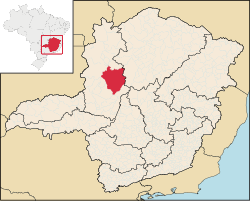João Pinheiro, Minas Gerais
João Pinheiro | |
|---|---|
| Município de João Pinheiro Municipality of João Pinheiro | |
| Nickname: Jomp's City | |
 Localization of João Pinheiro in Minas Gerais | |
| Country | |
| Region | Southeast |
| State | |
| Founded | August 30, 1911 |
| Government | |
| • Mayor | Carlos Gonçalves da Silva (PSDB) (2013-2016) |
| Area | |
• Total | 10.727460 km2 (4.141895 sq mi) |
| Elevation | 765 m (2,510 ft) |
| Population (2010)[1] | |
• Total | 45,260 |
| • Density | 4.22/km2 (10.9/sq mi) |
| Demonym | Pinheirense |
| Time zone | UTC-3 (UTC-3) |
| • Summer (DST) | UTC-2 (UTC-2) |
| Postal Code (CEP) | 38770-000 |
| Area code | +55 38 |
| Website | www.joaopinheiro.mg.gov.br |
João Pinheiro is a municipality in the state of Minas Gerais, Brazil.
History
The process of colonization of the region, now occupied by the city of João Pinheiro began probably in the half of the 18th century, the period preceding the discovery of gold mines in the regions with the movement of inputs and flags bearing the lands of Paracatu.
Prior to occupancy by the white man, the territory was inhabited only by Amerinds (the tribe of Cataguá) and fugitive [blacks]] of Paracatu and Goiás mines
By 1818, near the banks of the Vereda Extreme came a small town founded by pioneers and drovers who sought the captaincy of Goiás, this was the first landing of the white man in these parts. However, some of these adventurers settled animated by livestock and the diamond mines in the Rio Santo Antônio. It was a fever and this became the main activity of the camp nascent.
The town was named Santana Cheerful, this was the first name of the primitive camp belonging to the bishopric of Pernambuco - which gave the municipality current.
According to oral tradition, a very brave Curraleiro ox that lived in the vicinity of the site, often in the evening, went to the camp and remained there throughout the night mooing. The habit of that animal, called Alegre, intrigued everyone. It is said that this was the reason for the name of settlement.
In 1873, the village of Santana Merry was elevated to district (in land of Paracatu). Until 1902, the mining has been extensively explored by the river Santo Antônio bed and other waterways. On August 30, 1911, Santana Cheerful, received its current name, and went dismembered Paracatu. In 1925 you were granted fora-city and seat of municipality.
The city has a few parties of tradition, as is the case of the Cowboy Festival, held in April, the off-season carnival, João Pirô, held in October and Party City, held in September.
The patron saint is Our Lady of St. Anne, which lithurgic celebration happens at July 26.
See also
References
- ^ "Estimativas das Populações Residentes, em 31.12.2010, Segundo os Municípios" (in Portuguese). IBGE. Retrieved 2012-08-20.



